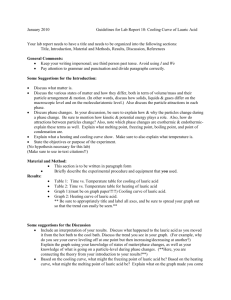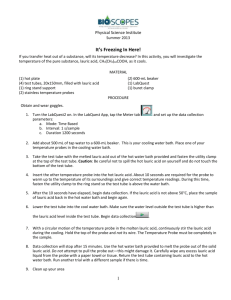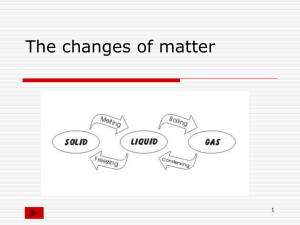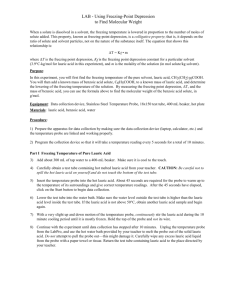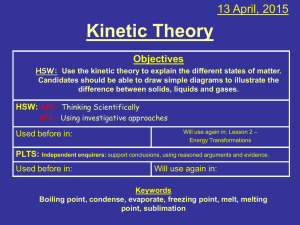Lab #3: Heating and Cooling Curve of Lauric Acid
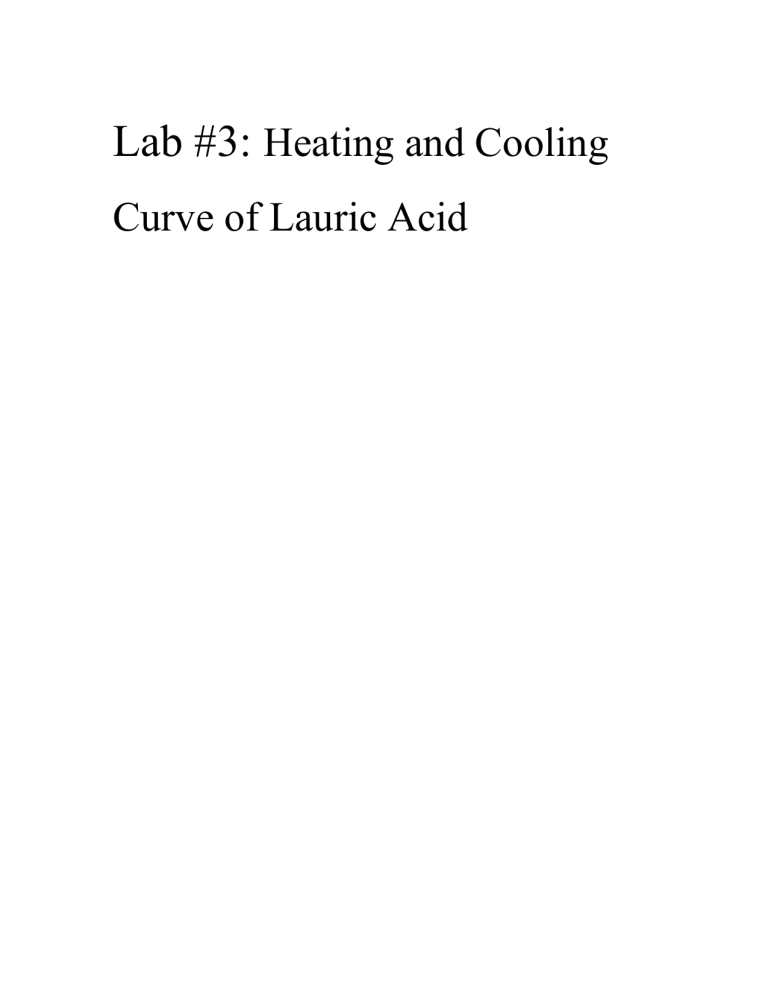
Lab #3:
Heating and Cooling
Curve of Lauric Acid
Introduction
Matter is anything that takes up space. Matter is anywhere and everywhere
(“What is Matter?”, n.d.). The states of matter are used to classify the different kinds of matter. Matter is classified into different states by the shape, volume, and the particles of the material. The different states of matter are solids, liquids, gases, plasma, and Bose-
Einstein Condensate. Plasma is rarely found on earth and the Bose-Einstein Condensate can only exist at extremely low temperatures around absolute zero (0Kelvin). Most matter can be classified as solids, liquids, or gases (Wysession, Frank, & Yancopoulos,
2004).
Solids have a definite shape and a definite volume. The particles in a solid have little energy and are tightly packed together. The particles have strong intermolecular forces, attractive forces between molecules, which make them stay together and don’t allow them to move around much, they only vibrate. Solids are denser than both liquids and gases. Solids usually have an organized arrangement of particles (“Classifying
Matter”, n.d.).
Liquids have a definite volume but no definite shape because they take the shape of their container. The particles of a liquid are have more energy than a solid and are also not as tightly packed. The particles have the ability to move around but there are still intermolecular forces which keep the particles together. Liquids are less dense than solids but more dense than gases. Liquids have a more random arrangement of particles than solids.
Gases have neither a definite volume nor a definite shape because gases spread out to fill the entire container. Gas particles have a lot of energy and are not packed
tightly. Gas particles have the freedom to move around. They move in straight lines until they bounce off a surface. Gases are the less dense than solids and liquids and have a weak intermolecular force which allows them to move around. Gases particles are not arranged in a regular pattern.
Phase changes are when a substance changes from one state of matter to a different state of matter. During a phase change, the temperature stays constant while the heat energy changes. When a substance is being heated or cooled but not undergoing a phase change, the potential energy stays constant while the kinetic energy goes up. When a substance is is in the middle of a phase change, the kinetic energy is constant while the potential energy goes up. The potential energy is used for either the addition or subtraction of intermolecular forces so the attractions of the particles change (“Causes of
Phase Change”, n.d.). It’s an exothermic change when a system releases energy to its surroundings. And when a system absorbs energy from its surroundings, it’s an endothermic change.
The melting point of a substance is the temperature when a solid changes to a liquid. The temperature of when a liquid vaporizes to a gas is the boiling point. The freezing point of a substance is the temperature where there is a change from a liquid to solid. The temperature at which a gas changes to a liquid is the point of condensation.
A heating curve shows what happens to the temperature of a substance as it is being heated. It can be used to determine the temperature at which a solid changes to a liquid, the melting point, and the temperature at which a liquid changes to a gas, the boiling point. A cooling curve shows what happens to the temperature of a substance as it is being cooled. The cooling curve can help you determine the temperature where a gas
changes to a liquid, the condensation point, and the temperature where a liquid changes to a gas, the freezing point. Temperature is the average kinetic energy of particles
(Wysession, Frank, & Yancopoulos, 2004).
The objective for this lab was to examine the heating and cooling curve of lauric acid and then determine the melting and freezing point. The reason of this lab was also to learn about matter, the different states of matter, and the phase changes of matter.
Methods & Materials
The materials used were one two glass thermometers, a hot plate, a ring stand, a test tube clamp, a test tube with lauric acid, and two 400mL beakers.
The sample was first prepared. It was done by first setting up the ring stand with the test tube clamp secured firmly on the stand with the hot plate underneath. Two
400mL beakers were filled with water 2/3 full and one of them was placed on the hot plate set to the dial 4. One of the thermometers was placed in the water. When the temperature leveled out, the test tube with the lauric acid was fastened in the test tube clamp over the beaker so that the lauric acid was completely submerged in the water.
When the lauric acid began to melt, the other glass thermometer was placed in the test tube and used it to stir the lauric acid.
The cooling curve and heating curve were determined after the sample was prepared. First the temperature of the lauric acid was made sure it was between 55°C and
70°C. The lauric acid was quickly moved into the cool water bath so that it was completely submerged. The temperature was taken down at zero seconds and every fifteen seconds until the temperature of the lauric acid reached 28°C.Observations were made and recorded. After it reached 28°C, it was taken out of the cool water bath and placed in the hot water, which was still in the range of 55°c to 70°C. The lauric acid should be stirred with the thermometer. The temperature was taken at zero second and every fifteen second until the lauric acid’s temperature reached 55°C. Observations were taken down. A graph was created to show the heating and cooling curve of the lauric acid.
The percent error was also calculated for the experimental freezing and melting point.
Results
Table 1: Time vs. Temperature for the Cooling Curve
Time (seconds)
Temperature(°Celsius)
Observation
0s
15s
30s
61°C
49°C
46°C
It was a liquid.
It was still a liquid.
Liquid begins thicken.
45s
60s
75s
45°C
44°C
44°C
44°C
Started to get hard on the bottom
Began to harden around the side
90s
105s
120s
44°C
43°C
43°C
It was getting hard.
135s began to become white
150s
165s
180s
195s
210s
225s
43°C
43°C
43°C
43°C
43°C
42°C
42°C
Almost fully hardened;white
240s It was solid
255s
270s
42°C
41°C
41°C
285s
300s
315s
330s
345s
360s
40°C
39°C
38°C
37°C
36°C
34°C 375s
390s
405s
32°C
31°C
420s
30°C
435s
29°C
450s
29°C
465s
28°C It was a solid.
The temperature of the lauric acid stayed at 43°C for many 15 second intervals (from 120s to 210s). It took the temperature of the lauric acid a long time to cool down compared to the time it took to heat up.
Table 2: Time vs. Temperature for the Heating Curve
Time (seconds)
Temperature(°Celsius)
Observation
0s
15s
30s
27°C
33°C
36°C
38°C
It was a solid.
45s There was some liquid.
60s
40°C
There were some small pieces of the acid that were solid.
75s
48°C
It was completely a liquid; it was clear.
90s
66°C
105s
72°C
The lauric acid’s temperature did not stay at one temperature for more than one 15 second interval. The temperature of the lauric acid increased very quickly compared to the temperature in the cooling curve.
Figure 1: The Cooling Curve and Heating Curve of Lauric Acid
80
70
60
50
40
30
20
10
Cooling Curve
Heating Curve
0
0 30 60 90 120 150 180 210 240 270 300 330 360 390 420 450
Time (seconds)
It took a lot less time to heat the lauric acid than it took to cool it. During the cooling curve the temperature of the lauric acid stayed the same for awhile but the temperature in the heating curve did not instead it kept on rising. The melting point for the lauric acid might be 44°C. The freezing point of the lauric acid might be 43°C.
Calculations
%𝒆𝒓𝒓𝒐𝒓 =
|𝒂𝒄𝒄𝒆𝒑𝒕𝒆𝒅 − 𝒆𝒙𝒑𝒆𝒓𝒊𝒎𝒆𝒏𝒕𝒂𝒍|
× 𝟏𝟎𝟎 𝒂𝒄𝒄𝒆𝒑𝒕𝒆𝒅
Freezing Point: 0.0046% =
|43.2−43|
× 100
43.2
Melting Point: 0.0185% =
|43.2−44|
× 100
43.2
Table 3: Percent Error of Melting and Freezing Point
Freezing Point
Accepted Value
43.2°C
Experimental
Value
43°C
Melting Point 43.2°C 44°C
% Error
0.0046%
0.0185%
Discussion
According to Figure 1, the curves are flat in some areas and rise or drops in others because it is indicating if the substance is in a phase change or not. When the curve is flat or constant that shows that the temperature is not changing because the kinetic energy is not changing. But during a constant temperature, the potential energy is changing. During a phase change in a heating curve the potential energy is increasing so the intermolecular forces can be broken so that there is less of an attraction force. In a phase change on a cooling curve the potential energy is decreasing so it will create more attractive forces.
When the lauric acid was being moved from the hot water bath to the cool water bath, the temperature changed even before it reached the cool water bath. This could be because while the lauric acid was at a high temperature, the air in the lab was a lot cooler so it cooled the lauric acid down before it reached the cool water bath.
The cooling curve shows that the freezing point of lauric acid might be 43 degrees
Celsius. On Figure 1, it shows that the lauric acid was at 43°C for many fifteen second intervals which mean the temperature was constant and when a temperature is constant as it is being heated it is undergoing a phase change. The phase change was from a liquid to a solid. Based on the heating curve, the melting point of lauric acid could be 44 degrees
Celsius. The heating curve does not show a constant temperature because the temperature only recorded every fifteen seconds and the lauric acid heated a lot quicker than it cooled down. But as the lauric acid was being heated, it was observed that at 60seconds when the temperature was at 40°C, the lauric acid still had pieces of solid but at 75 second when the temperature was at 48°C, the lauric acid was completely liquid. This means that the melting point is somewhere between 40°C and 48°C.The experimental values of the
melting point and freezing point are different but should be the same because a solid would melt at the same temperature as a liquid would freeze if they were the same substance.
In Table 3, it shows the experimental values are not the same as the accepted values for the freezing and melting point of lauric acid. The accepted value of the melting and freezing point of lauric acid is 43.2 degrees Celsius. The data recorded might be different because the temperature was only taken every fifteen seconds when it should have been recorded more often for both curves so there would be a more precise value for the melting and freezing point.
Another error that could have affected the results for the heating curve is that during the heating process the test tube with the lauric acid was broken from stirring the lauric acid with the glass thermometer. It was broken after the temperature reached 55°C but the test tube could have had a small crack which would allow the hot water to go inside of the tube. If hot water did reach the inside of the test tube then some of the results of the heating curve would be incorrect.
Based on the data, the boiling point and point of condensation of a substance is most likely the same temperature. The temperature of a substance as it boils or condenses stays constant. It would stay constant while the heat energy is being used to either make particles more attractive or less attractive.
The objectives of the experiment which was to determine the melting point and freezing point of lauric acid was met.
References
Causes of Phase Change. (n.d.). In Changing Matter.
Retrieved October 25, 2010 from http://www.schools.utah.gov/curr/science/core/8thgrd/sciber8/matter/html/phaschng.htm
Classifying Matter. (n.d.). In Classification . Retrieved October 24, 2010 from http://www.schools.utah.gov/curr/science/sciber00/7th/classify/sciber/clmatter.htm
Matter.(n.d.). In What is Matter?
. Retrieved October 42, 2010 from http://www.schools.utah.gov/curr/science/sciber00/8th/matter/sciber/intro.htm
Wysession, M., Frank, D., & Yancopoulos, S. (2004). Physical Science: Concepts in
Action with Earth and Space Science.
New Jersey: Pearson Prentice Hall.
